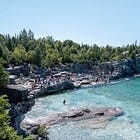Saugeen Ojibway Nation Raises Alarm After Construction Activity Begins Near Known Burial Site
Saugeen Ojibway Nation confirms recent ground disturbance near a burial site where ancestral remains were found in 2023 and says the site remains undeclared, highlighting legislative gaps.

The Saugeen Ojibway Nation (SON) has issued a public statement following reports of construction activity adjacent to a known burial site within SON Territory, and says the activity has raised renewed concerns about the adequacy of Ontario’s laws for protecting Indigenous burial grounds.
According to SON, a community member reported on the evening of Thursday, July 3, 2025, that a homeowner was widening a driveway on a property adjacent to a site where ancestral remains had been confirmed in the fall of 2023, also during construction.
SON Environment Office (SON EO) staff immediately visited the area, confirmed ground disturbance involving heavy equipment, and contacted the Municipality of South Bruce Peninsula and the Bereavement Authority of Ontario (BAO) to request a Stop Work Order.
However, SON states that the Town of South Bruce Peninsula informed them on July 4 that the municipality did not have the authority to halt the work.
SON continues to press for intervention from all relevant authorities and has reiterated the need for stronger legal protections.
The site in question has not yet been formally declared a burial site under Ontario law—a process required for protective measures such as construction monitoring and buffer zones to be enforced. SON says it has submitted multiple requests for formal designation, but progress has been slow.
“This situation underscores the serious gaps in Ontario’s legislative framework when it comes to the protection of Indigenous cultural heritage and burial sites,” SON stated in its release. The Nation emphasized that while it acted quickly to respond to the report, the failure to prevent disturbance reflects “systemic barriers—not a lack of will or action by the SON.”
When asked by The Owen Sound Current whether the property owner had been previously informed about the burial site's location, or whether SON had asked them to stop work, a communications representative replied: “Due to the culturally sensitive nature of this situation, we will not be providing further public comment at this time. We can confirm that we are in communication with the property owner and are working to better understand the scope of the activity that took place.”
The exact location of the burial site has not been disclosed. SON stated in a public FAQ that it does not share addresses of burial locations in order to protect them from curiosity-driven disturbance, vandalism, or accidental harm.
“We ask for understanding and support in ensuring these sacred sites remain protected and treated with the care and respect they deserve,” the document reads.
SON reiterated that its staff acted immediately upon receiving the report and continues to seek enforcement action, legal remedies, and stronger legislative authority to prevent future disturbances. The Nation also encouraged the public to report suspected disturbances and support legislative reform by engaging elected officials.
“We remain committed to ensuring accountability and continue to push for the legislative changes and protections that our ancestors deserve,” SON stated.
South Bruce Peninsula did not respond to our request for comment prior to publication.
Related:






